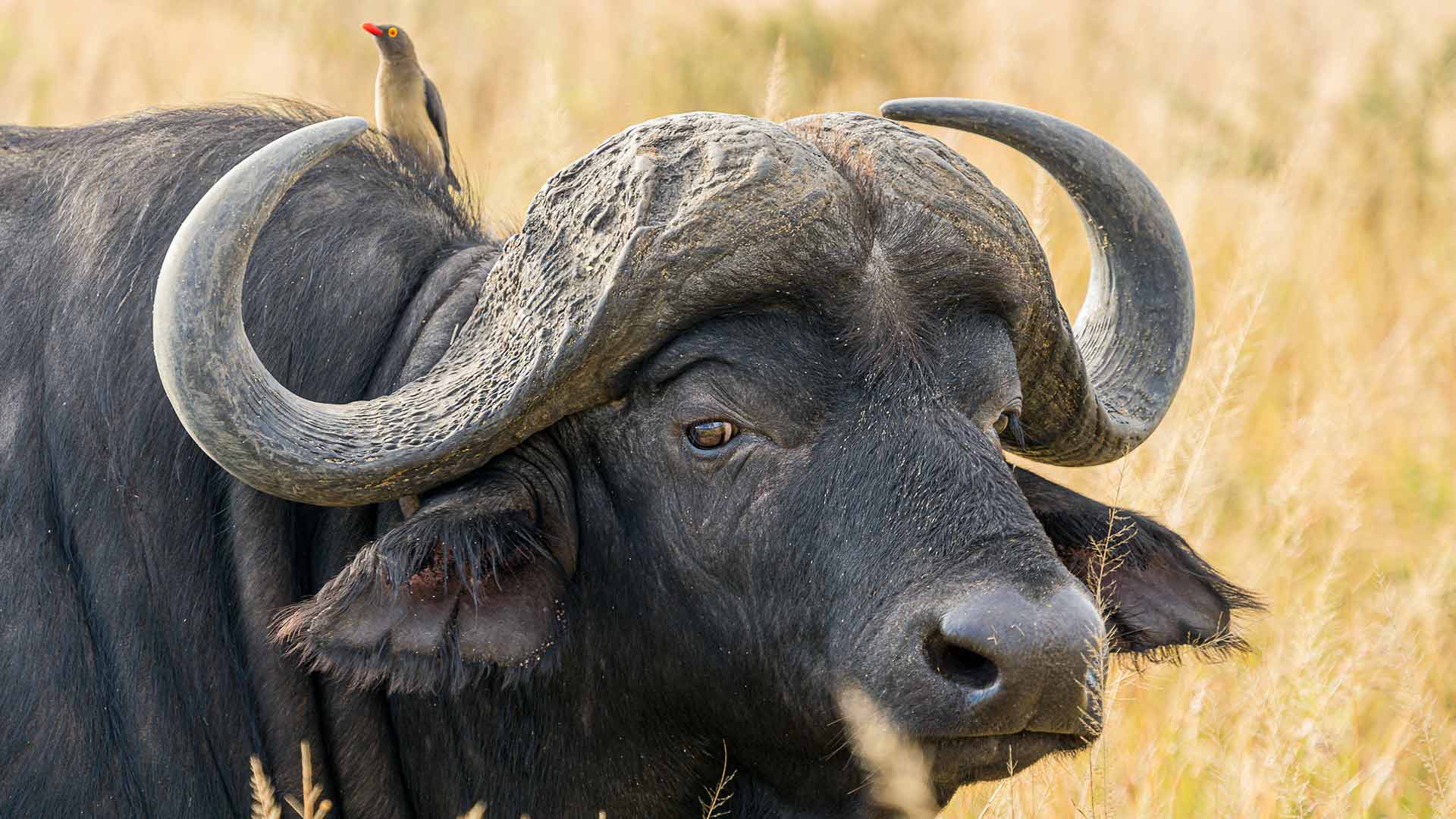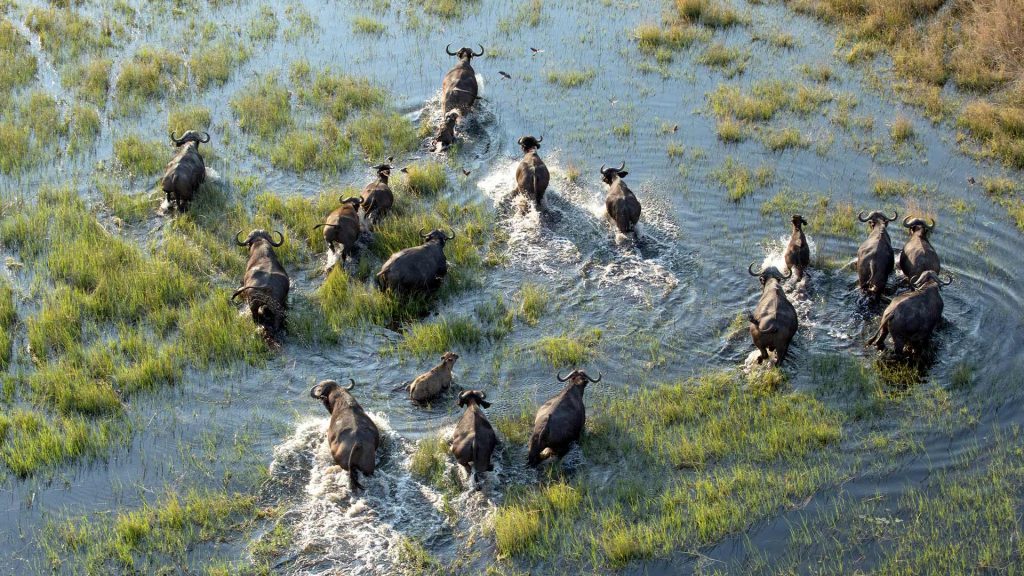African Buffalo
The African buffalo, Syncerus caffer, is a powerful herbivore known for its large, curved horns and social herds. Learn about their species in Africa, physical description, behaviour, habitat, and geographical distribution.

Overview
The African buffalo, scientifically known as Syncerus caffer, is one of the most formidable and iconic animals on the continent. Often found in large herds, these impressive creatures are known for their strength, social structure, and resilience.
Species in Africa
There are four recognized subspecies of the African buffalo:
- Cape Buffalo (Syncerus caffer caffer): The largest and most common subspecies, found in Southern and Eastern Africa.
- Forest Buffalo (Syncerus caffer nanus): Smaller and lighter in color, this subspecies inhabits the dense forests of Central and West Africa.
- West African Savanna Buffalo (Syncerus caffer brachyceros): Found in the savannas of West Africa, this subspecies is intermediate in size between the Cape and Forest buffalo.
- Central African Buffalo (Syncerus caffer aequinoctialis): Found in the savanna regions of Central Africa, it is similar in appearance to the West African Savanna buffalo.
Scientific Classification
- Kingdom: Animalia
- Phylum: Chordata
- Class: Mammalia
- Order: Artiodactyla
- Family: Bovidae
- Genus: Syncerus
- Species: Syncerus caffer
Description
The African buffalo is a large and robust herbivore, often recognized by its imposing horns and solid build. It is an animal that commands respect and caution due to its unpredictable nature and strength.
Size
African buffaloes are large animals, with males (bulls) typically weighing between 500 to 900 kilograms (1,100 to 2,000 pounds) and females (cows) weighing between 400 to 700 kilograms (880 to 1,540 pounds). They stand about 1.0 to 1.7 meters (3.3 to 5.6 feet) tall at the shoulder.
Body
They have a sturdy, muscular build with a broad chest and a short, stocky body covered in dark, coarse hair. The coat color ranges from dark brown to black.
Horns
One of the most distinctive features of the African buffalo is its horns, which are present in both males and females. The horns are fused at the base, forming a continuous bone shield known as a “boss.” Bulls have larger, more curved horns compared to cows.
Head and Face
The buffalo has a large head with a pronounced snout and large nostrils. Its eyes are positioned to provide a wide field of vision, which is vital for detecting predators.

Behavior, Diet, Reproduction, and Lifespan
Behaviour
African buffaloes are social animals that live in herds ranging from a few dozen to several hundred individuals. Their social structure is complex, and they exhibit a variety of behaviors that ensure the survival and cohesion of the herd.
- Herd Structure: Herds are typically composed of related females and their offspring, along with a few dominant males. Younger males may form bachelor groups, and older males often live solitary lives or in small groups.
- Communication: Buffaloes communicate through vocalizations, body language, and scent marking. They use a range of sounds from low grunts to loud bellows to convey different messages, such as signaling danger or coordinating movement.
- Defense Mechanisms: When threatened, buffaloes will form a protective circle around the calves, with the adults facing outward to confront predators. They are known to be aggressive when provoked, and their powerful horns are formidable weapons.
Diet
African buffaloes are herbivores, primarily grazing on grasses but also consuming other plant materials when necessary.
- Feeding Habits: Buffaloes spend a significant portion of their day grazing. They have a complex digestive system that allows them to process large amounts of fibrous plant material.
- Water Dependency: They require regular access to water and are often found near rivers, lakes, and wetlands. During the dry season, buffaloes may travel long distances to find water.
Reproduction and Lifespan
Female buffaloes reach sexual maturity around five years of age. After a gestation period of approximately 11 months, they give birth to a single calf, although twins are rare. Calves are typically born during the rainy season when food is abundant.
Mothers are highly protective of their calves, which stay with them for about a year before becoming more independent. The bond between mother and calf is strong, ensuring the young buffalo’s survival.
In the wild, African buffaloes can live up to 20 to 25 years, while in captivity, they may live slightly longer due to the absence of predators and availability of veterinary care.
Habitat and Geographical Distribution
African buffaloes are highly adaptable and can be found in a variety of habitats across sub-Saharan Africa, from savannas and grasslands to forests and wetlands. Their geographical distribution is extensive, reflecting their adaptability and resilience.
In Kenya, buffaloes are commonly found in Amboseli National Park, Tsavo National Park, and the Maasai Mara. Amboseli, with its diverse habitats and proximity to Mount Kilimanjaro, provides an ideal environment for buffaloes. Tsavo East and Tsavo West is known for its large buffalo herds and vast landscapes, while the Maasai Mara offers abundant grazing grounds.
In Tanzania, the Serengeti National Park and Ngorongoro Crater are key habitats for buffaloes. The Serengeti, famous for its annual migration, supports large herds of buffaloes that graze the expansive plains. The Ngorongoro Crater, a unique caldera, provides a rich and diverse ecosystem where buffaloes thrive.
Botswana is home to significant buffalo populations, particularly in Chobe National Park and the Okavango Delta. Chobe is renowned for its large buffalo herds that congregate along the Chobe River, and the Okavango Delta, a UNESCO World Heritage site, offers a lush, water-rich habitat ideal for buffaloes.
South Africa features buffaloes in Kruger National Park and Addo Elephant National Park. Kruger, one of Africa’s largest game reserves, supports healthy buffalo populations across its diverse habitats. Addo, initially established to protect elephants, now harbors a variety of wildlife, including buffaloes.
Namibia hosts buffaloes in Caprivi Strip and Bwabwata National Park. The Caprivi Strip, with its floodplains and riverine forests, provides excellent grazing grounds for buffaloes, while Bwabwata offers a mix of habitats that support diverse wildlife populations.
In Zambia, South Luangwa National Park and Kafue National Park are notable buffalo habitats. South Luangwa, famous for its walking safaris, hosts large herds of buffaloes, and Kafue, one of Africa’s largest national parks, offers varied landscapes that are ideal for buffalo populations.
In Zimbabwe, Hwange National Park and Mana Pools National Park are key locations for buffaloes. Hwange, the country’s largest game reserve, is renowned for its buffalo population. Mana Pools, a UNESCO World Heritage site, provides a unique riverside habitat that supports diverse wildlife, including buffaloes.
In Uganda, Queen Elizabeth National Park and Murchison Falls National Park are important buffalo habitats. Queen Elizabeth offers a mix of savannas, forests, and wetlands, while Murchison Falls features dramatic waterfalls and extensive savannas, both supporting healthy buffalo populations.
In Mozambique, buffaloes inhabit Gorongosa National Park, which has seen a remarkable recovery in wildlife populations due to successful conservation efforts. The park’s diverse habitats provide excellent conditions for buffaloes.
In Ethiopia, buffaloes can be found in the Omo National Park and the Gambella National Park. These areas offer rich, diverse ecosystems that support large herds of buffaloes.
Conservation
African buffaloes face several threats, including habitat loss, human-wildlife conflict, and diseases such as bovine tuberculosis. Conservation efforts are crucial to ensure their survival and maintain ecological balance.
Facts
Interesting facts about The African Buffalo.
African buffaloes use their large size, strength, and formidable horns to defend themselves. When threatened, they form a protective circle around the calves, with adults facing outward to confront predators such as lions and hyenas.
Buffaloes communicate through a variety of vocalizations, body language, and scent marking. They use sounds like grunts, snorts, and bellows to convey different messages such as warning of danger or coordinating group movements.
African buffalo herds are typically composed of related females and their offspring, led by a dominant female. Males may either live solitary lives, join bachelor groups, or, if dominant, stay with the herd to mate and protect the group.
Female buffaloes are highly protective of their calves. Calves stay with their mothers for about a year and are nurtured within the safety of the herd. The herd’s collective vigilance and protective behavior ensure the calves’ survival.
African buffaloes are herbivores that primarily graze on grasses. They may also consume other plant materials such as leaves and herbs, especially during the dry season when grasses are scarce. Their diet is high in fiber, and they spend much of their day feeding.
In the wild, African buffaloes typically live up to 20 to 25 years. In captivity, where they are protected from predators and have access to regular veterinary care, they may live slightly longer.
African buffaloes are highly adaptable and can thrive in various habitats, including savannas, grasslands, forests, and wetlands. Their ability to move long distances in search of water and grazing grounds helps them survive in changing environments.
The primary threats to African buffaloes include habitat loss due to agricultural expansion, human-wildlife conflict, diseases such as bovine tuberculosis, and poaching. Conservation efforts are crucial to mitigate these threats and ensure their survival.
African buffaloes are known for their unpredictable and aggressive nature, particularly when wounded or cornered. They are considered one of the most dangerous animals in Africa, responsible for numerous human fatalities each year. It is essential to maintain a safe distance and respect their space in the wild.
Buffaloes are essential grazers that help maintain the health of grasslands and savannas. Their grazing habits promote plant growth, prevent bush encroachment, and create habitats for other wildlife species, thereby supporting biodiversity.
Other Animals
Explore fauna in Africa.






